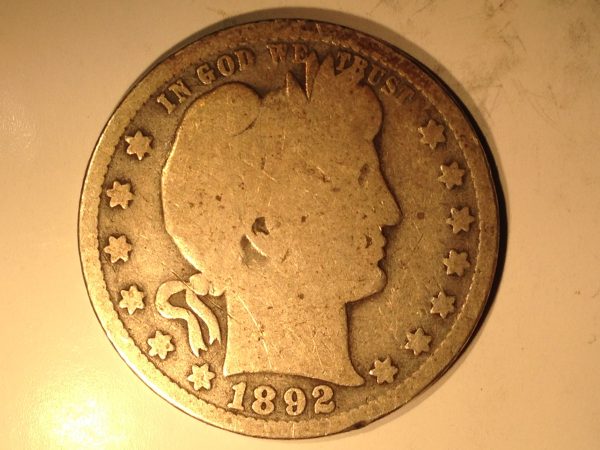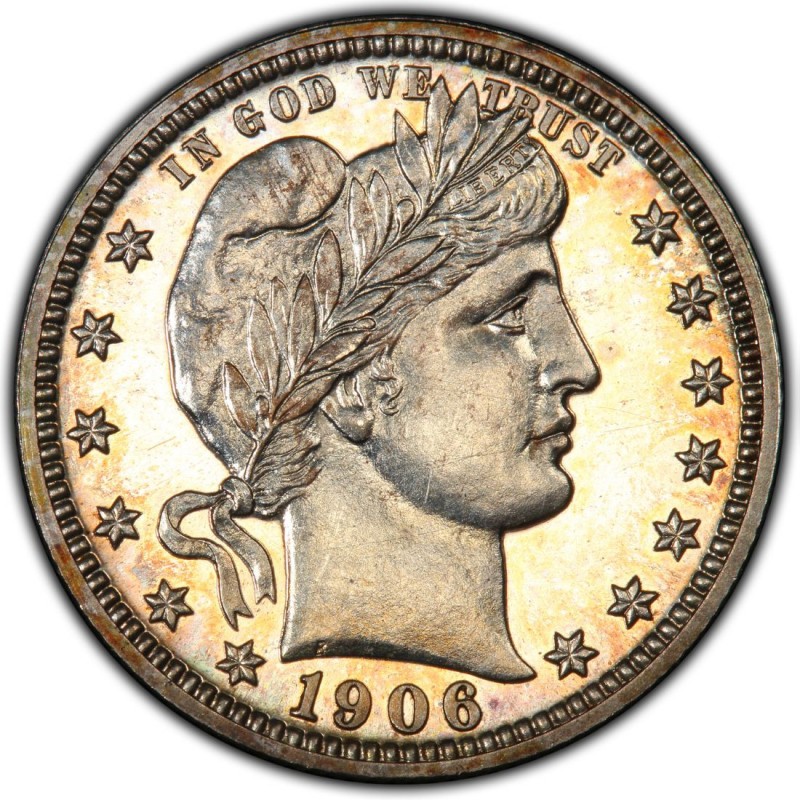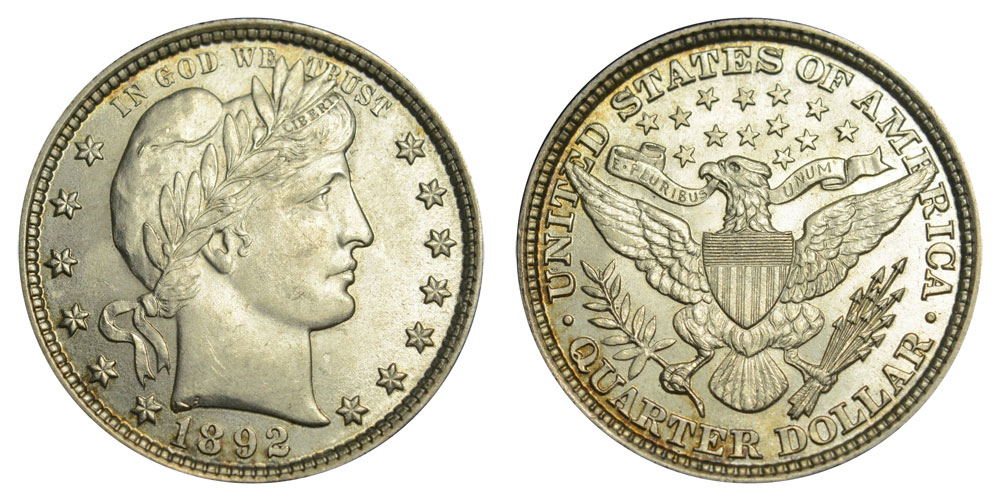The Barber Quarter was minted from 1892 to 1916. For the initial portion of the series from 1892 until 1903, coins were struck each year at the New Orleans and San Francisco Mints. From 1906 until the end of the series, production took place at the Denver Mint for most years. After 1909, no further coins for the denomination were struck at New Orleans.
Barber Quarters Design. In November of 1891, Leech approved the designs for all three coins and received President Benjamin Harrison’s approval. Although Barber requested additional time to prepare and test more dies, none was awarded. The new coins were struck on January 2, 1892 at the Philadelphia Mint. Unmistakable are the signs of wear to a Barber quarter in the Fine grade. However much of the major details remain giving a pleasant appearance. A wreath is seen and distinct cap is visible and on the reverse most of the arrow shafts are clear. Barber quarters wear well and in Fine condition have an appeal and value to many collectors. The obverse design of the Barber Quarter features the head of Liberty. She is facing right and wear a cap with most of her hair bound beneath. The cap has a laurel wreath and a band inscribed “Liberty”. The design is completed with “In God We Trust” above, the date below, and an arrangement of thirteen stars.

The mintages range from a high of more than 12 million for two years to an absolute low of just 40,000 pieces for the 1913-S Barber Quarter. The two other notable low mintage years are the 1901-S with a total of 72,664 pieces produced, and the 1896-S with at 188,039. These three issues command significant premiums even in well circulated grades and represent “stoppers” for most collections.
Barber Quarter Mint Mark

Below is a table displaying the mintages for Barber Quarters struck for circulation.
Barber Quarter Mintages



Barber Quarter Set
| 1892 | 8,236,000 |
| 1892-O | 2,640,000 |
| 1892-S | 964,079 |
| 1893 | 5,444,023 |
| 1893-O | 3,396,000 |
| 1893-S | 1,454,535 |
| 1894 | 3,432,000 |
| 1894-O | 2,852,000 |
| 1894-S | 2,648,821 |
| 1895 | 4,440,000 |
| 1895-O | 2,816,000 |
| 1895-S | 1,764,681 |
| 1896 | 3,874,000 |
| 1896-O | 1,484,000 |
| 1896-S | 188,039 |
| 1897 | 8,140,000 |
| 1897-O | 1,414,800 |
| 1897-S | 542,229 |
| 1898 | 11,100,000 |
| 1898-O | 1,868,000 |
| 1898-S | 1,020,592 |
| 1899 | 12,624,000 |
| 1899-O | 2,644,000 |
| 1899-S | 708,000 |
| 1900 | 10,016,000 |
| 1900-O | 3,416,000 |
| 1900-S | 1,858,585 |
| 1901 | 8,892,000 |
| 1901-O | 1,612,000 |
| 1901-S | 72,664 |
| 1902 | 12,196,967 |
| 1902-O | 4,748,000 |
| 1902-S | 1,524,612 |
| 1903 | 9,669,309 |
| 1903-O | 3,500,000 |
| 1903-S | 1,036,000 |
| 1904 | 9,588,143 |
| 1904-O | 2,456,000 |
| 1905 | 4,967,523 |
| 1905-O | 1,230,000 |
| 1905-S | 1,884,000 |
| 1906 | 3,655,760 |
| 1906-D | 3,280,000 |
| 1906-O | 2,056,000 |
| 1907 | 7,192,000 |
| 1907-D | 2,484,000 |
| 1907-O | 4,560,000 |
| 1907-S | 1,360,000 |
| 1908 | 4,232,000 |
| 1908-D | 5,788,000 |
| 1908-O | 6,244,000 |
| 1908-S | 784,000 |
| 1909 | 9,268,000 |
| 1909-D | 5,114,000 |
| 1909-O | 712,000 |
| 1909-S | 1,348,000 |
| 1910 | 2,244,000 |
| 1910-D | 1,500,000 |
| 1911 | 3,720,000 |
| 1911-D | 933,600 |
| 1911-S | 988,000 |
| 1912 | 4,400,000 |
| 1912-S | 708,000 |
| 1913 | 484,000 |
| 1913-D | 1,450,800 |
| 1913-S | 40,000 |
| 1914 | 6,244,230 |
| 1914-D | 3,046,000 |
| 1914-S | 264,000 |
| 1915 | 3,480,000 |
| 1915-D | 3,694,000 |
| 1915-S | 704,000 |
| 1916 | 1,788,000 |
| 1916-D | 6,540,800 |